One of the film’s most beloved actors, Jimmy Stewart, made more than 80 films in his lifetime. He was known for his everyman quality, which made him both appealing and accessible to audiences.
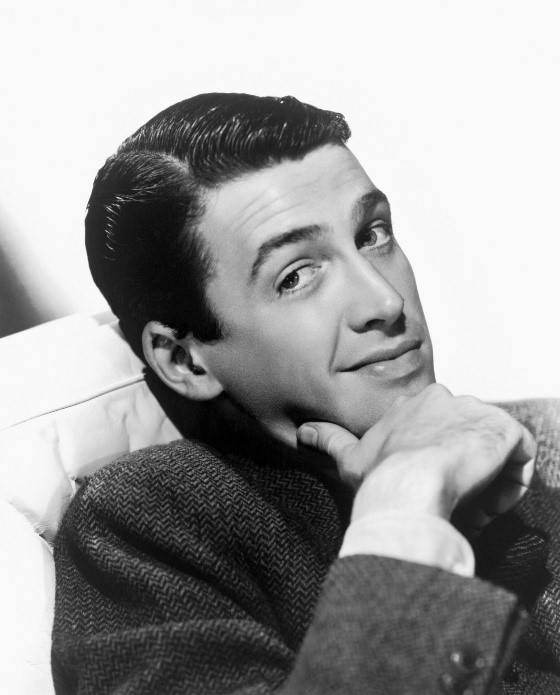
Stewart got his first taste of performing as a young man. At Princeton University, he was a member of the Triangle Club and acted in shows they produced. Stewart earned a degree in architecture in 1932, but he never practiced the trade. Instead, he joined the University Players in Falmouth, Massachusetts, the summer after he graduated. There Stewart met fellow actor Henry Fonda, who became a lifelong friend.
That same year, Stewart made his Broadway debut in “Carrie Nation.” The show didn’t fare well, but he soon found more stage roles. In 1935, Stewart landed a movie contract with MGM and headed out west.
In his early Hollywood days, Stewart shared an apartment with Henry Fonda. The tall, lanky actor worked a number of films before co-starring with Eleanor Powell in the 1936 popular musical comedy “Born to Dance.” The movie featured the Cole Porter hit “Easy to Love.” Another career breakthrough came with Frank Capra’s “You Can’t Take It with You” (1938). This comedy won an Academy Award for Best Picture and made Stewart a star.
Stewart also played the lead in Capra’s “Mr. Smith Goes to Washington” (1939). In this film, he portrayed a young, idealistic politician who takes on corruption. Stewart received his first Academy Award nomination for this film. The following year, he took home Oscar gold for “The Philadelphia Story.” It was clear that Stewart was now a bona fide movie star.
As Stewart’s meteoric rise in popularity was taking place in Hollywood, Europe was on the edge of war. Hitler had embarked on military aggression against tiny Austria in 1938, followed by Czechoslovakia and Poland in 1939. Britain and French were eventually were drawn into war with Germany. Americans, on the other hand, wanted to stay out of the war. Stewart, however, wanted the opportunity to serve his country – hopefully as a pilot in the U.S. Army Air Corps.
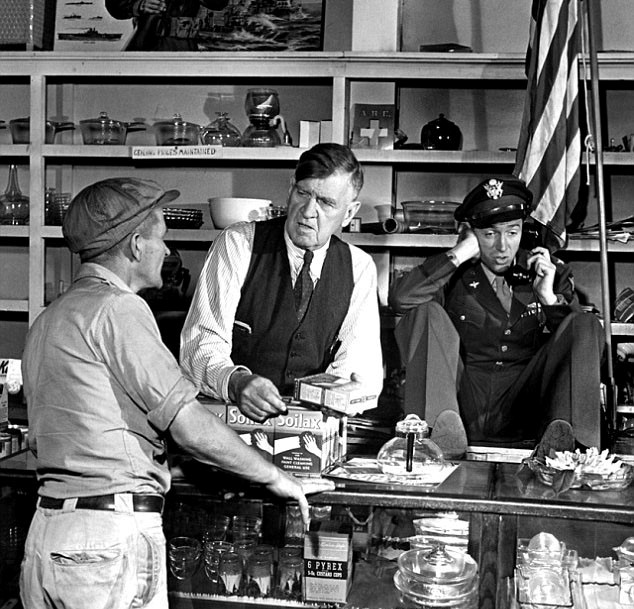
As a child in Indiana, his interest in aviation led him to take his first flight from one of the barnstorming pilots that used to travel the Midwest. As a successful actor in 1935, Jimmy was able to afford flying lessons. He received his civilian pilot’s license in 1935 and bought his first airplane, a Stinson 105. In 1938 he obtained his commercial pilot’s license. He often flew cross country to visit his parents in Pennsylvania, navigating by the railroad tracks.
Jimmy Stewart Biography
Born on May 20, 1908, in Indiana, Pennsylvania, Stewart was the son of Elizabeth Ruth Jackson and Alexander Maitland Stewart, who owned a hardware store. His family on both sides had deep military roots with veterans of the American Revolution, the War of 1812 and the American Civil War in which both grandfathers had fought. His father had served during both the Spanish–American War and World War I. Stewart considered his father to be the biggest influence on his life, so it was not surprising that, when another war came, he too was eager to serve.
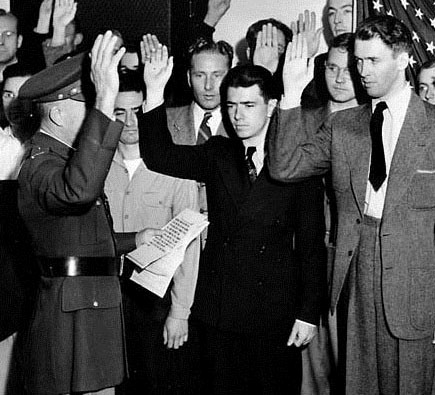
All but certain the United States would eventually be drawn into the war; President Franklin Roosevelt signed into law the Selective Training and Service Act of 1940 requiring men between the ages of 21 and 36 to register with local draft boards. That was in September 1940. One month later, Stewart was drafted into the U.S. Army. His draft number was 310, but though he was 6-foot-3, he weighed only 138 pounds. When the Army turned him down as too skinny, he started eating spaghetti twice a day, supplemented with steaks and milkshakes. To get up to 143 pounds, he sought out the help of Metro-Goldwyn-Mayer’s muscle man and trainer Don Loomis, who was noted for his ability to help people add or subtract pounds in his studio gymnasium. Stewart later attempted to enlist in the U.S. Army Air Corps, but still came in underweight. Determined to achieve his goal of becoming a military pilot, he successfully convinced the Army doctor into adding an ounce or two so he could enlist and on March 22, 1941, he was inducted as a private in the U.S. Army, becoming the first major American movie star to wear a military uniform prior to World War II. Other established actors followed, such as Clark Gable (U.S. Army Air Force), Henry Fonda (U.S. Navy), and Tyrone Powers (U.S. Marine Corps).
The night before he left for training, MGM threw a farewell party for its departing star. Most of the actresses present that evening kissed him goodbye, and Rosalind Russell wiped off the lipstick with her handkerchief and wrote each girl’s name on it. Stewart kept the hanky for good luck.
He was sent to Fort MacArthur, Calif., where cameramen hounded him, following him even when he was issued his underwear. Witnessing all that unwanted attention, one old soldier remarked sympathetically, “You poor bastard.” Stewart’s salary dropped from $12,000 per week to $21 per month, but he dutifully sent a 10 percent cut ($2.10) to his agent each month.
Jimmy Stewart Underwent Basic Training at Moffett Field
Stewart underwent basic training at Moffett Field, Calif., where a crowd of girls waited just outside the gates, eager to get a glimpse of their idol. It got so bad that his commanding officer put up a sign requesting civilians to leave Stewart alone until after he finished his training. He was commissioned as a 2nd Lt. on January 18, 1942. Appearing in uniform at the Academy Awards the following month, he presented the Best Actor Oscar to Gary Cooper for “Sergeant York.”
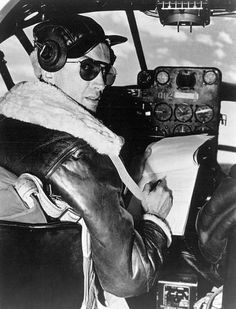
Though Stewart subsequently narrated two training films, “Fellow Americans” and “Winning Your Wings,” and lent his star power to a few radio shows and war bond tours, in general, he resisted efforts to capitalize on his career. The military, however, fearful of losing a major celebrity in action, wanted to keep him safe and sound in the United States, but this was not enough for Stewart. Instead, he requested more flying time – and he soon got his wish. First, he became a flight instructor in Curtiss AT-9s at Mather Field, Calif. From there, he went to Kirkland Field, N.M., for six months of bombardier school. In December 1942, he requested a transfer to the four-engine school at Hobbs, N.M. Finally, he reported to the headquarters of the Second Air Force in Salt Lake City.
Still looking for more than desk duty, Stewart was sent to Gowen Field in Boise, Idaho, and the 29th Bombardment Group, where he became a flight instructor on B-17 Flying Fortresses. During that time, his roommate was killed in an accident, and three of his trainees were lost in another mishap. One student remembered, “Stewart was known for being one of the few officers who never left the airfield tower until every single plane had returned.”
On one night flight with a student pilot, Stewart left the copilot’s seat to check on equipment in the nose and let a new navigator sit in the right-hand seat. Suddenly the no. 1 engine exploded, sending pieces of shrapnel into the cockpit and knocking the pilot senseless. With the engine on fire and wind tearing through the windows, the navigator froze at the controls. Stewart had to pull him out of the seat, so he could take over, hit the fire extinguishers, and land on three engines.
Rumor that Jimmy Stewart Would be Taken Off Flying Status
In March 1943, 35-year-old Stewart was transferred to the 703rd Squadron, 445th Bomb Group, in Sioux City, Iowa, as the Operations Officer. As much as he wanted combat duty, he began to believe it was unreachable. However, a rumor that Stewart would be taken off flying status and assigned to making more training films or selling bonds called for immediate action. He appealed to his commander, 30-year-old Lt. Col. Walter E. Arnold Jr., who understood his situation and recommended Stewart to the commander of the 445th Bombardment Group, a B-24 Liberator unit that had just completed initial training at Gowen Field for deployment to Europe. He was promoted to Captain in the summer of 1943.
On November 11, 1943, Captain Stewart led his 24 B-24H Liberators to England by way of Florida, Brazil, Senegal, and Morocco. They became part of the 2nd Air Division, Eighth Air Force, stationed at RAF Tibenham, Norfolk, England.
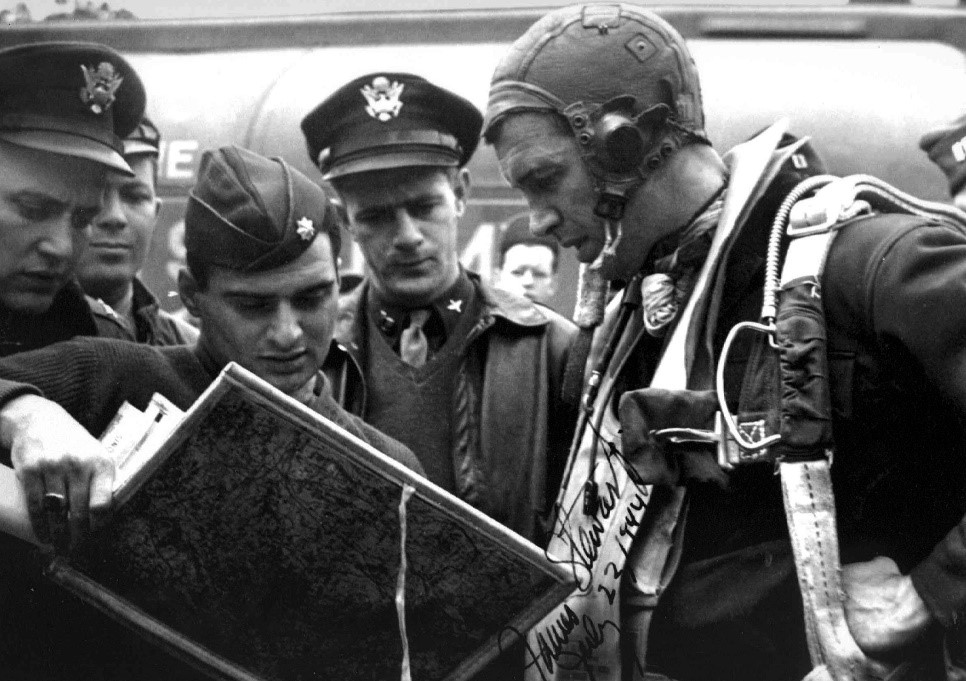
Stewart’s Jimmy First Combat Mission was to Bomb the U-boat Facilities at Kiel
Following a few shakedown flights, Stewart’s first combat mission was to bomb the U-boat facilities at Kiel on December 13, 1943, flying a B-24 that had been named ‘Nine Yanks and a Jerk’ by a previous crew. As the flight got underway, Stewart’s dream was finally realized – he was in combat. The biggest shock was the flak from anti-aircraft guns. Their bombers yawed left and right and pitched up and down as explosions went off all around them in the sky. None of Stewart’s planes were shot down during the raid, but soon the bodies began to fall.
This was followed three days later by a mission to Bremen, the second largest port in Germany. During the raid, enemy fighters took down a bomber called ‘Good Nuff.’ Of the crew of ten, just three parachuted out. Now for the first time, Stewart had to write a letter to the parents of the dead airmen saying they were missing and presumed dead.
During his third mission, his group was ordered to hit V-1 launching sites at Bonaire’s, France. Coming in low at 12,000 feet, 35 B-24s plastered the target near the coast, then returned to base without even being targeted by flak or fighters. If two of the Liberators hadn’t collided on takeoff, it would have been a perfect mission.
The worst was one that Stewart did not actually fly on, but his squadron did. The raid on the city of Gotha, Germany, led to the loss of 13 planes, or 130 men all in one go.
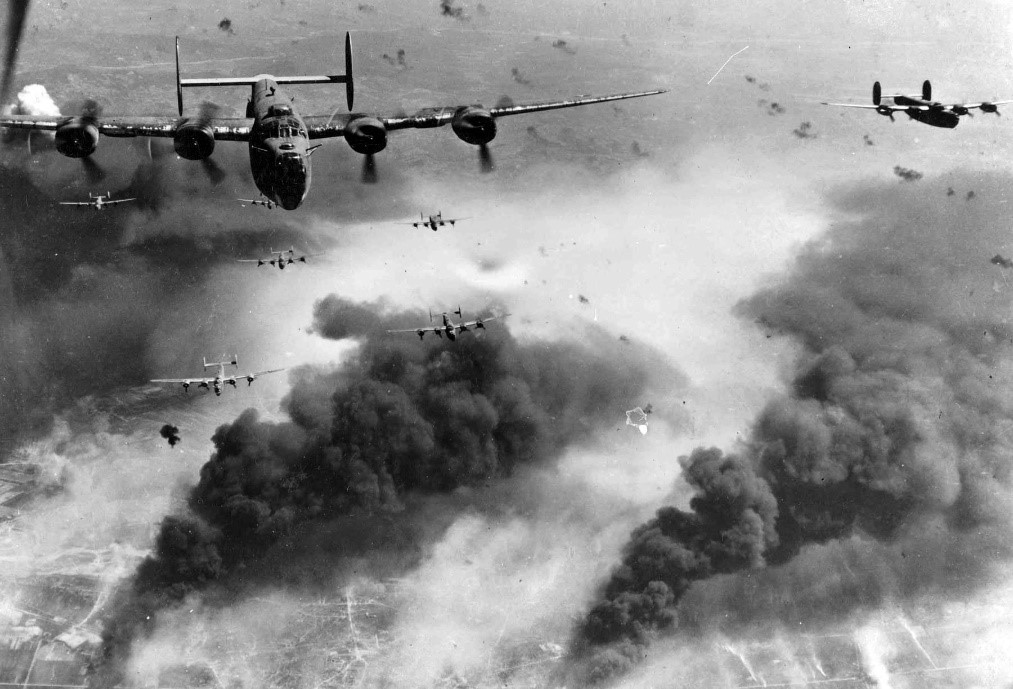
For more than two hours, Nazi fighters “poured death and destruction” at Stewart’s men from every direction. They used cables with bombs attached to them to bring their bombers down, fired rockets ‘like the Fourth of July’, and fired rockets at will.
Nazi pilots followed the planes as they went down to make sure there were no survivors.
Those who survived told horrific tales of bodies flying through the air and planes exploding in front of them. Stewart heard all this and knew that the next day he had to lead the next nearly identical mission. That night he did not sleep; miraculously, his flight was nowhere near as bad.
A mission over Mannheim ended in catastrophe when they lost two planes with 20 men inside. And as the weeks went on, this all began to weigh heavily on Stewart.
He was a perfectionist, and he was so hard on himself. Unable to sleep, he became more and more worn down by the demanding flights that became more and more bloody.
Jimmy Stewart was Awarded the Distinguished Flying Cross
Following a mission to Ludwigshafen, Germany, on January 7, 1944, Stewart was promoted to Major. Stewart was awarded the Distinguished Flying Cross for actions as deputy commander of the 2nd Combat Bombardment Wing on February 20, 1944, the first day of a five-day operation intended to lure the Luftwaffe into a decisive battle by launching massive attacks on the German aircraft industry. He also flew two other missions during the operation known as “Big Week.”
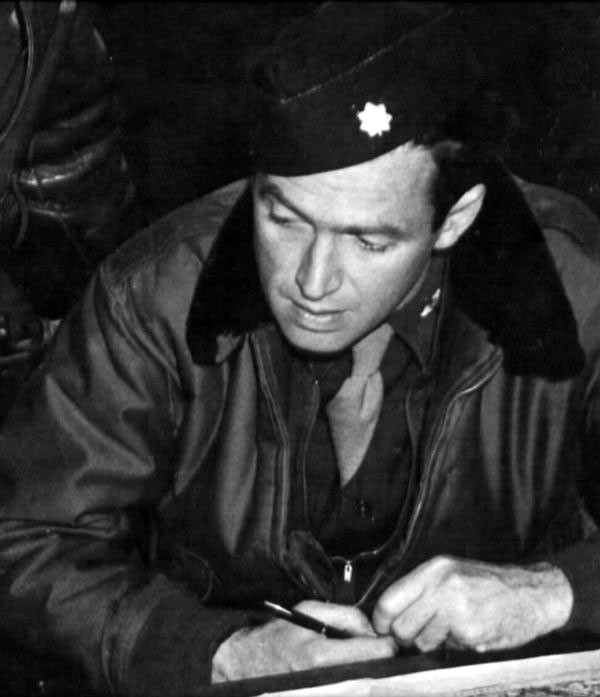
Jimmy Stewart Took the Blame Himself, Something Which Earned Him Ultimate Respect
Perhaps the episode which disturbed Stewart the most was a raid that went terribly wrong. The 453rd was assigned to bomb a V-1 rocket facility in the northern French village of Siracourt. The instruments in Stewart’s cockpit malfunctioned, and 12 bombers deployed their payloads on the city of Tonnerre instead. At least 30 tons of general-purpose bombs rained down, causing unknown numbers of civilian casualties.
Stewart’s pilots tried to cover for him, but he took the blame himself, something which earned him their ultimate respect.
The actor-turned-commander was a successful, popular officer. His roommate at the time recalled: “I always got the feeling that he would never ask you to do something he wouldn’t do himself. Everything that man did seemed to go like clockwork.”
He also took care of his men. When Stewart found out the finance officer wouldn’t have enough money for his crew for a few days, he threatened to have him transferred to the infantry unless they were paid immediately. And when one of his crews hid a keg of stolen beer in their barracks, he ambled in, threw off the covers and drew himself a glass, then announced that there was a keg of beer around there somewhere, it was a very serious matter, and it should be taken care of immediately if they ever found it. He then finished his beer and walked out.
On January 7, after bombing Ludwigshafen, Stewart noticed that the lead group, the 389th, was 30 degrees off course and slowly diverging from the protective fire of the rest of the formation on the way back to base. Knowing the bombers’ new direction would take them directly over Luftwaffe airfields in northern France, he radioed the lead plane and explained they were off course. The leader replied curtly that no, they weren’t – “and stay off the radio.”
Stewart faced a difficult decision. He could stay with the rest of the formation on the correct course, or he could follow his errant lead squadron. A two-squadron formation would be much more vulnerable, but a single squadron didn’t have much of a chance at all. He chose to stay with the 389th and add the defensive power of his own guns to theirs.
Sure enough, more than 60 Luftwaffe planes swarmed up from bases below. The commander of the 389th Bomb Group paid dearly for his mistake: His plane went down in flames. Seven other 389th B-24s were also shot down, but Stewart was lucky again; all the bombers in his squadron made it home. As a fellow officer would later point out, “There were a lot of lives saved that day because he knew what he was doing and when he had to do it.”
Stewart experienced what was probably his closest brush with death on February 25, 1944, during a nine-hour mission to Furth, unescorted most of the way. On that flight for the first time, waist gunners on the lead planes hurled bundles of chaff overboard to try to fool the German radar-directed anti-aircraft guns. It only succeeded in attracting them. Whenever they threw a bundle out, the flak became more accurate. The Germans hit the bombers with everything they had on that mission, including anti-aircraft rockets.

The 445th hit its target, but on the way home, a flak shell burst in the belly of Stewart’s Liberator, directly behind the nose wheel. Somehow the B-24 kept on flying – all the way back to base. But when the shrapnel-perforated bomber landed, its fuselage buckled. Just in front of the wing at the flight deck, the airplane cracked open like an egg. The crew climbed out, unhurt, and looked over their crippled aircraft. In his characteristically understated fashion, Stewart mused to a bystander, “Sergeant, somebody sure could get hurt in one of those damned things.”
The war eventually got to everyone, even calm, mild-mannered Jimmy Stewart. Pilots who flew with him said that he became ‘Flak Happy,’ a term to describe what is now known as Post Traumatic Stress Disorder, or PTSD, which would later serve him well in movies in which he was to express desperation and anger.
In author Robert Matzen’s “Mission: Jimmy Stewart And The Fight For Europe,” published by Paladin Communications, he wrote, “The nightmares come every night. There was on oxygen at 20,000 feet with 190s zipping past, spraying lead and firing rockets, flak bursting about the cockpit. B-24s hit, burning, spinning out of formation. ‘Bail out! Bail out! Do you see any chutes? How many chutes? Whose ship was it? Oh, God, not him? Not them!’ Bodies, pieces of bodies smacking off the windshield.”
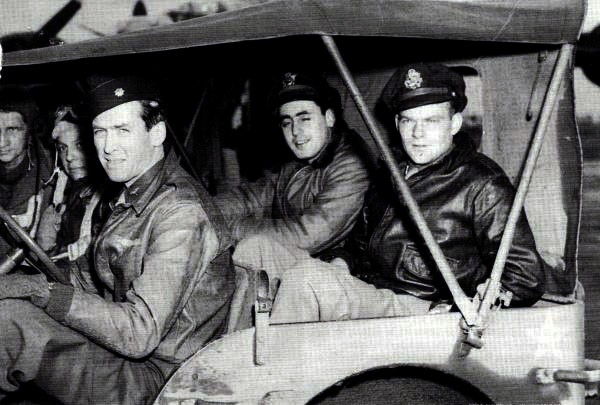
Jimmy Stewart was Transferred to Old Buckenham
Aside from an occasional trip to actor David Niven‘s house, a meeting with a dignitary or a quick sailing expedition, Stewart concentrated on the job at hand. “I prayed I wouldn’t make a mistake,” he recalled. “When you go up, you’re responsible.” Once a flight engineer went AWOL just before a mission, forcing his plane to fly without him. It didn’t return. Stewart was required to discipline the man, but he wondered, “How do you punish someone for not getting killed?”
After 20 B-24 missions, in early 1945, Stewart was transferred to Old Buckenham, becoming the operations officer of the 453rd Bomb Group, which flew B-17s. When he arrived in a B-24, he reportedly buzzed the tower until the controllers fled.
The 453rd’s lead Liberator, ‘Paper Doll’, had no permanently assigned copilot. That position was usually filled by one of the senior staff officers, often Stewart himself. Waist gunner Dan Brody recalled, “He exhibited himself as an excellent pilot, even under adverse conditions.”
Like the men of the 445th, his new group found Stewart unfailingly friendly. On the way back up the runway, for example, when he saw a pedestrian, he’d stop his jeep and drawl, “Hey fella, lak a ride?”
The senior staff normally rotated, flying every fifth mission, but Stewart went out of his way to lead 11 more sorties. While he liked the B-17, he still had a soft spot for the Liberator. He later said of the B-24, “In combat, the airplane was no match for the B-17 as a formation bomber above 25,000 feet, but from 12,000 to 18,000 it did a fine job.”
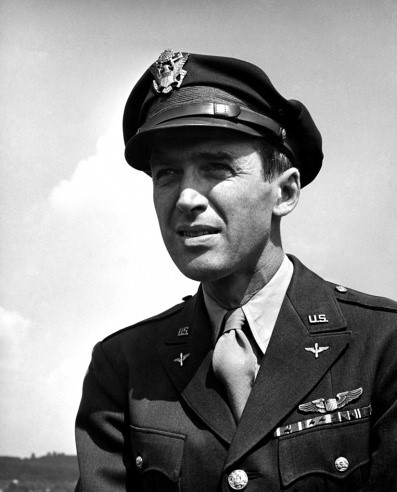
Jimmy Stewart was Promoted to Colonel and Chief of Staff
In April 1945, Stewart was promoted to Colonel and Chief of Staff of the 2nd Air Division. It was during this time, while he was sweating out the return of his planes from each mission, that his hair began to turn gray. Most of the men were amused to find they were being briefed by the famous actor. Extras often dropped in – among them radioman Walter Matthau, who thought he “was marvelous to watch.”
At the beginning of June 1945, Stewart was the presiding officer of a court-martial of a pilot and navigator charged with dereliction of duty for having accidentally bombed the Swiss city of Zurich the previous March – the first instance of personnel being tried for the attack on a neutral country. The court acquitted the defendants.
Stewart finally returned Stateside in September 1945 aboard the liner Queen Elizabeth. Predictably, he waited at the gangplank until all of his men had disembarked before coming ashore. Asked about his service in Europe, he commented, “I had some close calls – the whole war was a close call.” When he returned to Hollywood, he refused a lavish welcome home party, saying, “Thousands of men in uniform did far more meaningful things.”
In all, Stewart had served four-and-a-half years during World War II and was awarded the Air Medal with three oak leaf clusters, Distinguished Flying Crosses with one oak leaf cluster, and the French Croix de Guerre.
He rose from private to colonel in four years and participated in 20 often-brutal World War II combat missions over Germany and France. In mere months the war took away his boyish looks as he faced near-death experiences and the loss of men under his command. The war finally won, he returned home with millions of other veterans to face an uncertain future, suffering what we now know as PTSD. Younger stars like Gregory Peck were now getting roles that might have been Stewart’s, and he didn’t know if he would ever work in Hollywood again. Then came “It’s a Wonderful Life,” his first film in five years.
Frank Capra paid RKO for the rights to the story and formed his own production company, Liberty Films. The female lead went to Donna Reed when Capra’s perennial first choice, Jean Arthur, was unavailable, and after Ginger Rogers, Olivia de Havilland, Ann Dvorak, and Martha Scott had all turned down the role. Stewart appeared as George Bailey, an upstanding small-town man who becomes increasingly frustrated by his ordinary existence and financial troubles. Driven to suicide on Christmas Eve, he is led to reassess his life by Clarence Odbody, an “angel, second class” played by Henry Travers. It was a disappointment at the box office, but it became a holiday favorite over the years. Stewart reportedly considered it to be one of his favorite films.

The movie also enabled him to be ferocious and to show raw emotions when his character George Bailey channels his anger and guilt in the scene where he rages at his family. It’s almost certain that his extreme case of PTSD gave him a perspective and an emotional range that he did not have before the war. Some believed he would look for scripts where he could demonstrate that rage. Two such films that allowed him to explore his dark side were “Shenandoah” and “Winchester 73.“
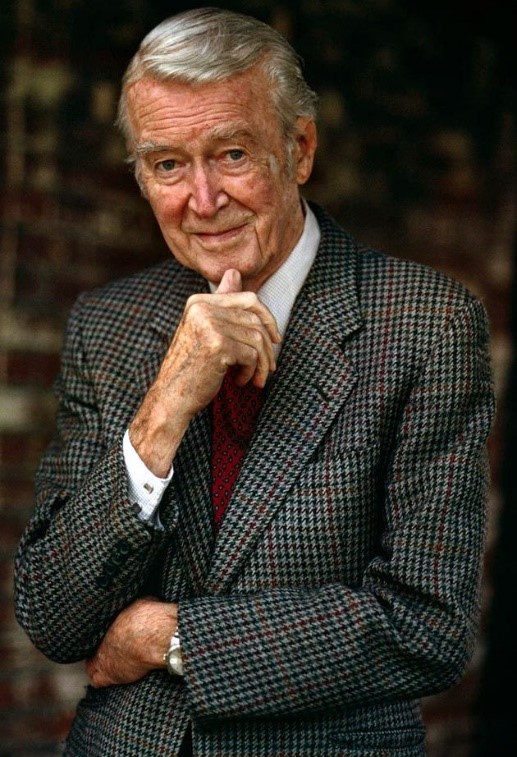
Jimmy Stewart was Promoted to Brigadier General
Stewart did not leave the military and continued to serve in the U.S. Air Force Reserves, where on July 23, 1959, he was promoted to brigadier general. During his active duty periods, he remained current as a pilot of Convair B-36 Peacemaker, Boeing B-47 Stratojet, and Boeing B-52 Stratofortress intercontinental bombers of the Strategic Air Command. On February 20, 1966, Brig. Gen. Stewart made one more combat flight – this time as an observer in a B-52 Stratofortress on an Arc Light bombing mission over North Vietnam. He refused the release of any publicity regarding his participation, as he did not want it treated as a stunt, but as part of his job as an officer in the Air Force Reserve. After 27 years of service, Stewart retired from the Air Force on May 31, 1968.
His stepson Marine 1st Lt. Ron McLean was killed in Vietnam on June 8, 1969, in Quang Tri Province.
Stewart became the recipient of numerous tributes during the 1980s for his substantial career. In 1984, Steward picked up an honorary Academy Award “for his high ideals both on and off the screen.” By the 1990s, Stewart had largely stepped out of the public eye. He was deeply affected by the death of his wife Gloria in 1994. The couple had been married since 1949 and had twin daughters together. He also became a father to her two sons from a previous marriage. Jimmy and Gloria Stewart were one of Hollywood’s most enduring couples, and his apparent love and commitment to her added to his reputation as an upstanding and honorable person.
During an interview late in life, the actor explained that WWII was “something I think about almost every day – one of the greatest experiences of my life.” Asked whether it had been greater than being in films, he said simply, “Much greater.”
Poor health plagued Stewart in his final years. He died in Beverly Hills, CA on July 2, 1997, at the age of 89. The cause of death was cardiac arrest and pulmonary embolism following respiratory problems.
While he may be gone, his movies have lived on and inspired countless other performers. Stewart’s warmth, good humor, and easy charm have left a lasting impression on American pop culture.

I was stationed at Loring AFB from Dec. 1956 thru July, 1960. I went to lunch at the Airmen’s mess sometime in 1959. The Airmen’s mess was adjacent to the NCO mess. General Stewart and his group came to lunch. I think it was planned for the NCO mess which had been gussied up. General Stewart looked into both Mess Halls and went into the Airmen’s Mess which wasn’t quite as prepared. True to his reported humilty as reported.
A/1st Class Philip M. Tull Salinas, Calif.
BG Jimmy Stewart swore a 150 of us new recruits into the Air Force (enlisted) in late May 1965 in Indianapolis Indiana. He was with his wife and one of his twin daughters. He was in civilian clothes which a General can do. It was held outside on a very nice day. He gave a short speech before the swearing in.
I was stationed at Bolling Air Force Base in Washington D.C. in 1960-1962. In 1961, General Stewart spent some time at Bolling Field fulfilling his reserve duty. A great American who served his country with honor and dignity. I was proud to tell my friends in my squadron, that I grew up in a small coal mining town located about 20 miles from General Stewart’s Home in Indiana, PA.